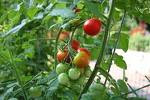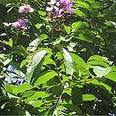In Pakistan carrots look very different to the ubiquitous orange ones on supermarket shelves in Europe and they are also a far cry from the disappointing woody ones that so often find their way into shopping bags. Here they are red or purple, and the red ones seem particularly red when seen on a barrow set against the white of a coconut. They look amazing and the taste doesn’t disappoint.
Wild carrots still grow, but the domesticated strain began life as small tough spindly roots which over the centuries became the thicker, fleshier roots we have today. The wild carrot is indigenous to parts of Europe and Asia and seeds have been found in excavations of Mesolithic sites, which means that we have been using carrots for more than 10,000 years. It is thought that the domesticated carrot, sativa, originated in what is now Afghanistan about 5,000 years ago and these were either the purple or yellow varieties. Natural orange mutants occurred and these were taken by the Dutch so that the orange carrot we have today was produced.
 There has been some confusion over the centuries about the carrot as the wild one was white and so could be confused with the parsnip, to which carrots, as members of the Umbelliferae family are related. They are also related to dill, fennel, caraway and cumin. In fact it is so confusing that no one is really sure if, during mediaeval times, herbalists and others were writing about the properties of the wild carrot, Daucus carota carota or the parsnip. This article is not concerned with the wild carrot, only the domesticated types.
There has been some confusion over the centuries about the carrot as the wild one was white and so could be confused with the parsnip, to which carrots, as members of the Umbelliferae family are related. They are also related to dill, fennel, caraway and cumin. In fact it is so confusing that no one is really sure if, during mediaeval times, herbalists and others were writing about the properties of the wild carrot, Daucus carota carota or the parsnip. This article is not concerned with the wild carrot, only the domesticated types. There are various paintings from the Middle Ages and later that show the carrot in them and archaeologists believe that purple carrots feature in temple paintings from ancient Egypt, dating back to around 2,000 BC.
 In Rome the wild carrot was used as an aphrodisiac and as part of a potion which was given as an antidote to poisoning. Galen (2nd century AD) named it Daucus to distinguish it from the parsnip and Dioscorides adequately describes the carrot. It is later that confusion sets in. In his cookery book of 230 AD Apicius gives the name carrots to this vegetable, and it is believed that the Romans introduced the carrot to Europe. After the fall of the Roman Empire, carrots inexplicably vanished into the mists of history, only to re-emerge in Europe in the 12th century.
In Rome the wild carrot was used as an aphrodisiac and as part of a potion which was given as an antidote to poisoning. Galen (2nd century AD) named it Daucus to distinguish it from the parsnip and Dioscorides adequately describes the carrot. It is later that confusion sets in. In his cookery book of 230 AD Apicius gives the name carrots to this vegetable, and it is believed that the Romans introduced the carrot to Europe. After the fall of the Roman Empire, carrots inexplicably vanished into the mists of history, only to re-emerge in Europe in the 12th century. The purple carrot spread into the Mediterranean area in the 10th century and the yellow mutant carrot is believed to have been developed there. Both colours of carrot spread from the Med to the rest of Europe.
In the reign of James I of England (James VI of Scotland) the green carrot fern-like tops were fashion accessories and worn in the hair. In 1633 Gerard calls this vegetable a carrot and says that it cured venomous bites and stomach problems.
 Red carrots, like tomatoes contain lycopene, especially the purple ones, and are rich in beta-carotene also possessing vitamins A, C, K and B-complex vitamins. They also contain the minerals manganese, zinc, potassium, phosphorous, magnesium, copper, calcium, folate and selenium, so with all these nutrients they have potent anti-oxidant properties and anti-inflammatory ones. Molybdenum and falcarinol) a phytonutrients that may be responsible for reducing the risks of cancer) are also present in carrots. Amino acids and bioflavonoids, including myricetin, kaempferol, quercetin and luteolen, are also present and the humble carrot is indeed good for our eyesight as our grandmothers said. They, like wimberries, improve our night vision and prevent macular degeneration. The red and purple carrots have a high lycopene content and this is believed to have anti-cancer properties. The purple colour is produced by anthocyanins a group of flavonoids also present in grapes, blueberries and cranberries. There are attempts being made to breed red a Chinese carrots with a maroon strain grown by a carrot breeder, Dr. Leonard Pike PhD at the Texas A and M University. The maroon ones have a high beta-carotene and anthocyanin content and the lycopene from the red carrot would make hybrids a super potent carrot for our health. Carrots as they are, however, can help protect us from cardio-vascular disease, some cancers, including those of the larynx, oesophagus and lung cancer, which is good news if you are a smoker.
Red carrots, like tomatoes contain lycopene, especially the purple ones, and are rich in beta-carotene also possessing vitamins A, C, K and B-complex vitamins. They also contain the minerals manganese, zinc, potassium, phosphorous, magnesium, copper, calcium, folate and selenium, so with all these nutrients they have potent anti-oxidant properties and anti-inflammatory ones. Molybdenum and falcarinol) a phytonutrients that may be responsible for reducing the risks of cancer) are also present in carrots. Amino acids and bioflavonoids, including myricetin, kaempferol, quercetin and luteolen, are also present and the humble carrot is indeed good for our eyesight as our grandmothers said. They, like wimberries, improve our night vision and prevent macular degeneration. The red and purple carrots have a high lycopene content and this is believed to have anti-cancer properties. The purple colour is produced by anthocyanins a group of flavonoids also present in grapes, blueberries and cranberries. There are attempts being made to breed red a Chinese carrots with a maroon strain grown by a carrot breeder, Dr. Leonard Pike PhD at the Texas A and M University. The maroon ones have a high beta-carotene and anthocyanin content and the lycopene from the red carrot would make hybrids a super potent carrot for our health. Carrots as they are, however, can help protect us from cardio-vascular disease, some cancers, including those of the larynx, oesophagus and lung cancer, which is good news if you are a smoker. On a more mundane level, carrots can also help to stop diarrhoea, and lower cholesterol levels. In Chinese medicine carrots are considered to be a neutral food having neither hot nor cold properties, and they are used for getting rid of coughs, including whooping cough, strengthening the spleen and pancreas, to improve the liver’s function, dissolve kidney and gall bladder stones, to cure tumours, to calm the stomach and get rid of heartburn and indigestion, to improve the hearing and stop earache, and to improve breast-feeding mothers’ milk flow. The juice is also expressed onto the skin for the relief of burns.
On a more mundane level, carrots can also help to stop diarrhoea, and lower cholesterol levels. In Chinese medicine carrots are considered to be a neutral food having neither hot nor cold properties, and they are used for getting rid of coughs, including whooping cough, strengthening the spleen and pancreas, to improve the liver’s function, dissolve kidney and gall bladder stones, to cure tumours, to calm the stomach and get rid of heartburn and indigestion, to improve the hearing and stop earache, and to improve breast-feeding mothers’ milk flow. The juice is also expressed onto the skin for the relief of burns. Carrots also have their uses in cosmetics, as they help to combat dry skin, stop acne and get rid of pimples etc. You should grate the carrots and apply them to the face for a face mask, or apply them to eczema, or wounds or burns. Leave the mask on your skin for ½ an hour before rinsing off with warm water.
Try our recipe for Carrot Halva which is delicious or the one below which is also a dessert recipe.
If you have children, or want an unusual table decoration, slice the tops off the carrots and put them in water on a saucer and watch them row their fern-like leaves.
Ingredients
1 kg carrots, cleaned and grated
3 litres milk
¾ cup of broken rice (or any basmati rice)
2 cups sugar
10 green cardamom pods crushed a little so that the flavour is released
50gr sultanas
50 gr desiccated coconut
a few drops of kiora essence (optional)
Method
Wash the rice and soak it for ½ hour in cold water. Drain.
Put carrots, rice and cardamoms in a heavy-bottomed pan and add the milk.
Simmer, uncovered, over a low heat for 2 hours. Scrape the sides and the bottom of the pan frequently, to incorporate the scrapings into the mixture and to prevent burning.
Stir continuously and scrape the sides and bottom of the pan until the carrots and rice are mushy (the consistency of thick porridge) and the milk has thickened.
Add the sugar stirring until it dissolves then add the sultanas and coconut.
Cook for a further 15-20 mins.
Remove from the heat and add kiora (kewra) essence if you are using it.
This dish can be served hot or cold.
This has Taste and is a Treat.











































